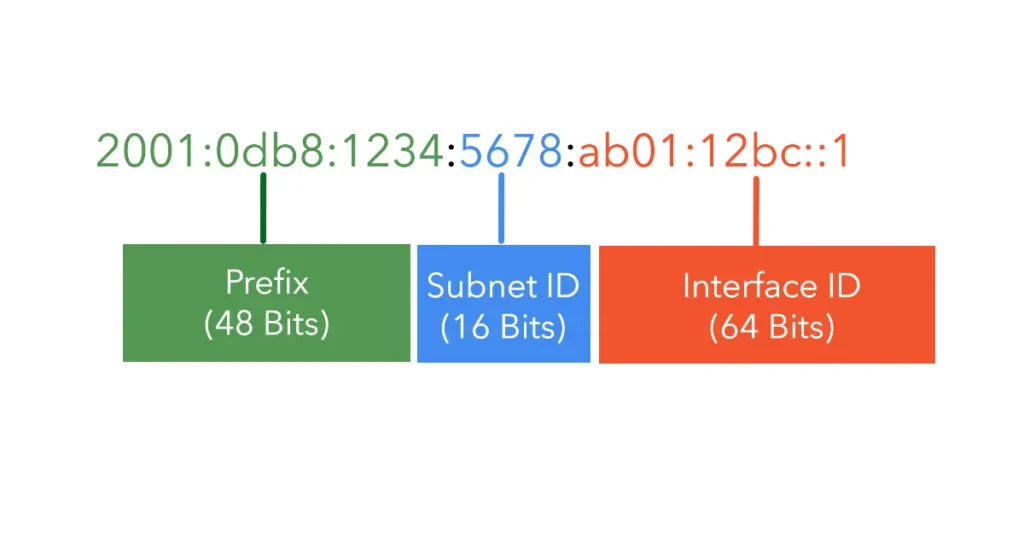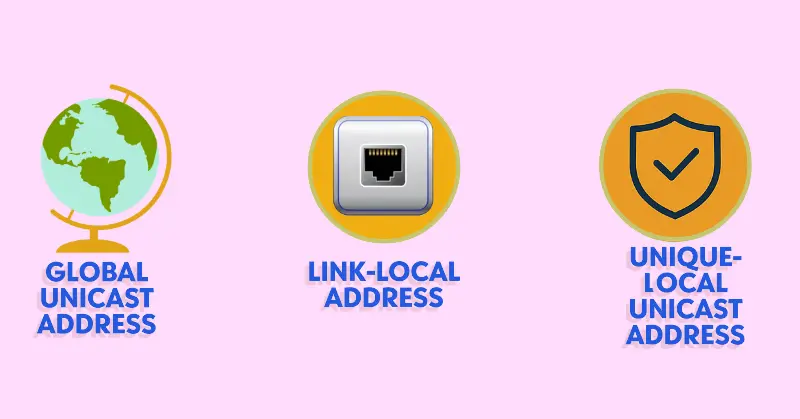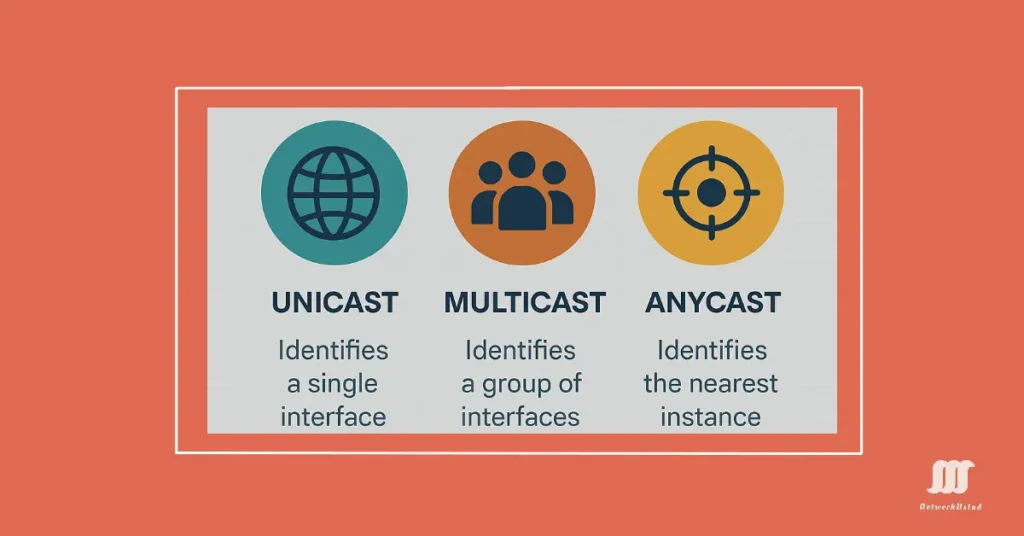IPv6 Address Types Explained: Unicast, Multicast, Anycast Guide for 2025
What are the IPv6 address types? This is the main topic of our comprehensive guide. My previous articles discussed IPv4 address classes, classless and classful addressing schemes, and special-purpose IP addresses. We have also learned about unicasting, multicasting, and broadcasting in IPv4 addresses. Similarly, IPv6 addresses also contain different types, such as unicast addresses, multicast addresses, and anycast addresses. In this article, I will give you a brief look at the various types of IPv6 addresses.
IPv6 addressing is the future of modern networking, designed to replace IPv4 with a vastly larger address space and enhanced features. As of April 2025, global IPv6 adoption is nearing 43.91% (per Google’s stats), making it critical for network professionals, students, and enthusiasts to understand its address types. This comprehensive guide explores IPv6 address types—unicast, multicast, and anycast—with practical examples, configurations, and visuals to simplify your learning journey.
Unlike IPv4, which uses 32-bit addresses and supports broadcasts, IPv6 uses 128-bit addresses and eliminates broadcasts, relying on multicast for group communication. Mastering IPv6 address types is essential whether you’re configuring a home router or designing an enterprise network. Let’s dive in!
What Are IPv6 Address Types?
IPv6 addresses are categorized based on their communication purpose, The address types are the following:
- Unicast: Delivers packets to a single, specific device (one-to-one).
- Multicast: Sends packets to a group of devices (one-to-many).
- Anycast: Routes packets to the nearest device in a group (one-to-nearest).
Unlike IPv4, IPv6 has no broadcast addresses—multicast handles group communication more efficiently. Below, we’ll explore each type with examples and use cases, updated for 2025 networking trends.
Unicast Address
A unicast address is the most common type of IPv6 address that we can assign only to one network interface. An IPv6 unicast address individually identifies an interface on an IPv6-enabled device. This unicast address is also used for one-to-one communication between different devices in the network. A packet sent to a unicast address receives the interface assigned to that address type.

The source IPv6 address must be a unicast address; however, the destination IPv6 address can be unicast or multicast. Unicast Addresses are the most common IPv6 address type used for direct communication like browsing a website or sending an email. IPv6 unicast addresses include several subtypes.
The types of IPv6 unicast are:
Global unicast addresses (GUA), link-local addresses, and unique local IPv6 unicast addresses. The most common are global unicast and link-local unicast addresses. The figure below illustrates IPv6 Unicast address types:-

Global Unicast Address
A global unicast address is just like a public IPv4 address. The addresses should be unique worldwide and can only be assigned once. It is a routable address across the Internet, like a public IPv4 address. We can configure global unicast addresses dynamically or statically. The Internet Assigned Numbers Authority (IANA) has assigned only 2000::/3 addresses to the global pool. The only assigned IPv6 pool is 2001::/16 to various Internet address registries. A global IPv6 address consists of two parts:
Subnet ID – The subnet ID is 64 bits long. It contains the site prefix, which can be assigned from a Regional Internet Registry, and the subnet ID.
Interface ID—The interface ID is also 64 bits long. It is typically composed of part of the interface’s MAC address. The figure below illustrates the different parts of the global IPv6 unicast address.

The first three bits are set to 001 because the prefix of a global IPv6 address is 2000::/3, So 0010000000000000 is 2000 in hexadecimal. The following 45 bits are the global routing prefix. This is the part that has been assigned to different organizations. The following 16 bits are for the subnet ID, which a network administrator can use for hierarchical addressing. The last 64 bits show the interface ID, the part of the IPv6 address that must be unique within a subnet.
Example:
2001:0db8:1234:5678::1 might be a web server’s address, routable worldwide.
Use Case: Hosting a website accessible globally.
IPv6 Link-local Addresses
Link-local addresses are used to communicate with other devices in the same network. They start with the hexadecimal character “FE”. In the IPv6 network, the term link refers to a subnet. We cannot route link-local addresses to the public network. However, we can dynamically configure them similarly to IPv4 link-local (169.254.0.0/16) addresses.
In the IPv4 network, link-local addresses are assigned because of some problem. However, in the IPv6 network, link-local addresses are configurable, and we can use them for communication within the local network. The link-local address must be unique within the local network. We cannot route the link-local address to the internet or public network.
We can identify the IPv6 Link-Local address with the leftmost 64 bits as the hexadecimal digits FE80. So, the first 16 bits are reserved for the prefix. The binary of FE80 is 1111 1110 1000 0000. The link-local network is FE80:: /64. The figure below illustrates the distribution of link-local address bits.

The link-local IPv6 is derived from the NIC’s MAC address. A MAC address is 48-bit address, and an IPv6 address is 128 bits. The steps for converting a MAC address to an IPv6 is the following: step by step:
- Get and write down the MAC address of the PC or device, for example, BC:85:56:60:ED:75
- Insert ff: life in the middle: BC:85:56:FF:FE:60:ED:75
- Reorder to IPv6 notation BC85:56FF:FE60:ED75
- Now it’s 4 hextet, convert the first two digits of hexadecimal to binary: BC> 10111100
- Flip the 7th bit: 10111100->10111110
- Convert it back to hexadecimal: 10111110 ->BE
- Change the first octet with a newly calculated one: BE85:56FF:FE60: ED75
- Insert the link-local prefix at the beginning : FE80::BE85:56FF:FE60:ED75
- You have done!
Example:
fe80::1%eth0 on a router’s Ethernet interface.
Use Case: Auto-configuring devices during network setup, like discovering neighbors.
Tip: Never manually assign link-local addresses—devices generate them automatically.
IPv6 Unique Local Addresses
The IPv6 unique local addresses have limited similarities to private IPv4 addresses, with some significant differences. An address registry does not allocate it and is not routed outside its local domain and network. Unique local addresses are used inside or between a limited number of sites. These addresses must not be routable in the global IPv6 and must not be translated to a global IPv6 address. The unique local address range is from FC00::/7 to FDFF::/7. The address block is divided into two /8 groups fc00::/8 and fd00::/8.
The group fc00::/8 has not been defined yet, and the group fd00::/8 is defined for /48 prefixes, formed by setting the 40 least significant bits of the prefix to a randomly generated bit string. The resultant format is like fdxx:xxxx:xxxx::
With the IPv4 addressing scheme, we required NAT (Network Address Translation) and PAT (Port Address Translation). This is done because of the limited availability of IPv4 address space. Many sites use the private nature of RFC 1918 addresses to secure or hide their network from possible security risks. However, this was never the purposeful use of these technologies. We can use unique local addresses for devices that will never need or have access from another network.
Example:
fd12:3456:789a::1 for a private server.
Use Case: Creating isolated networks in enterprises or IoT setups without public IP conflicts.
Note: Site-local addresses (fec0::/10) were deprecated in 2004 (RFC 3879)—avoid using them.
IPv6 Loopback Address
Just like in IPv4, the loopback address is an address that represents the same interface as a computer. Whenever we communicate to a loopback address, the TCP/IP protocol stack will loop the packets back on the same interface without even leaving the interface. The loopback addresses are typically for testing network applications without having network configurations. The IPv6 address reserved for loopback is 0000:0000:0000:0000:0000:0000:0000:0001/128—the simplified and short form of the IPv6 loopback address is::1/128.
IPv6 Unspecified Addresses
The IPv6 Unspecified address has all binary bits set to “0”. The operating systems used unspecified addresses before IPv6 address configuration. The IPv4 and IPv6 routers will not forward packets with the unspecified address. The unspecified IP address in IPv6 is 0000:0000:0000:0000:0000:0000:0000:0000/0 — the simplified and short form of this address is::/0.
Embedded IPv4 Address
The IPv6 address is used by hosts and routers to tunnel IPv6 packets dynamically under the IPv4 routing infrastructure. IPv6 nodes are assigned particular IPv6 unicast addresses that carry an IPv4 address in the low-order 32 bits. This type of address is called an Embedded IPv4 Address or IPv4-compatible IPv6 address. For example, if the route is 200.100.50.10, the embedded IPv4 address may be like:: 200.100.50.10.
Multicast Address
IPv6 multicast addresses work similarly to IPv4 multicast addresses. The IPv6-enabled devices can join and listen to multicast traffic on an IPv6 multicast address. The multicast address comprises an 8-bit address, 4-bit flag, 4-bit scope, and 112-bit group ID fields. An IPv6 multicast address can identify multiple network interfaces. In IPv6 multicasting, IPv6 datagram packets addressed to an IPv6 multicast address are delivered to all interfaces identified by the address. The IPv6 multicast address as:-
| Preferred | ff00:0000:0000:0000:0000:0000:0000:0000/8 |
| Leading 0s omitted | ff00:0:0:0:0:0:0:0/8 |
| Compressed | ff00::/8 |
Anycast Address
An IPv6 Anycast address is any IPv6 unicast address. We can assign this address to multiple network devices. Like a multicast address, an anycast address identifies multiple interfaces. However, while various machines accept multicast packets, Anycast packets are delivered to the nearest device with that address. The routing protocol determines the nearest. An Anycast address must be assigned to a router, not a host, and cannot be used as a source address.
Note—Broadcast addresses no longer exist in the IPv6 addressing scheme. However, an IPv6 all-nodes multicast address essentially gives the same result.
FAQs
-
IPv6 addresses are categorized into unicast, multicast, and anycast. Each type serves a unique purpose in network communication, such as one-to-one, one-to-many, or one-to-nearest communication.
